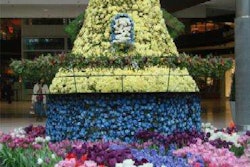The 10-percent cost increase lighting usually adds to a landscape project often allows property owners to benefit from their outdoor spaces 10 times as much, making it a practical investment, contends Ken DePratt, president of KD Poolscapes, Franksville, Wisconsin. “Lighting gives homeowners a different time of day – night – to enjoy their backyard,” DePratt says. “That’s when most people have time to enjoy it – after work.”
Jim O’Loughlin, vice president of marketing for All American Turf Beauty, a Nite Time Décor franchisee in Van Meter, Iowa, says a growing number of people are interested in outdoor lighting, either to showcase their homes, entertain in their backyards, or improve security.
In some markets, lighting has gone from basic – illuminating paths and the occasional tree – to complex lighting systems that wash structures and many landscape elements with soft, ambient light, says Mitch Kalamian, principal and landscape designer, Solena Landscape,
Huntington Beach, California. A mature tree, for instance, requires at least three lights in order to be lit effectively, he says. The latest trend is to light water features abundantly. “We’re designing more elaborate water features, and lighting has to keep up with that,” Kalamian says. Fiber-optic lighting, with its ability to display numerous colors and light shows, is becoming a popular option for water features.
Here’s how three landscape companies used lighting to bring a new dimension to recent projects.
1. Highlighting an architectural gem
Objective: Light the historic Stockman House, designed by Frank Lloyd Wright and now a Mason City, Iowa, museum, so the public can appreciate the renowned architect’s work at night.
Challenges: The board of directors in charge of the museum hired Nite Time Décor by All American Turf Beauty to handle the project. The historical significance of the 1908 structure required the company follow preservation rules. For example, no fixtures or wires could be mounted to the building and fixtures could not be visible. The company had to position fixtures in their proposed locations and gather the entire board of directors for a nighttime demonstration to approve installation.
The plan: Uplighting was the best way to highlight the architectural details of the Stockman House, says Jim O’Loughlin with All American Turf Beauty. This method allowed light to fill the home’s expansive eaves and spill back with a soft, warm glow. To create the effect, the company used 15 low-voltage well lights with various lenses on them to spread light appropriately. Workers either buried the fixtures or installed them in specially built metal risers needed to prevent shrubbery, which couldn’t be pruned, from interfering with the light. Positioned behind the shrubs, the risers are hidden, but raise the fixtures to the necessary level. Deciding what to light was relatively easy, O’Loughlin says. “We were following the lines of the world’s greatest architect,” he says. “There are nice lines to the house – the lighting just followed them.” The company also concentrated on lighting the home’s many corners.
Outcome: “They’re extremely happy,” O’Loughlin says of the board members, who wrote a testimonial for All American Turf Beauty, explaining how pleased they are with the project. O’Loughlin says the company has received many compliments regarding the job.
Cost to client: Approximately $3,500
2. Ambient light throughout the landscape
Objective: Owners of a Long Beach, California, home built in 1910 wanted to restore the home, inside and out, to the look of the era in which it was built. They requested outdoor lighting as part of the landscape renovation, but, like many homeowners, were more concerned with the overall look than with the nuts and bolts of how the lighting portion of the job would be accomplished, says Mitch Kalamian with Solena Landscape.
Challenges: Because the lot is a large one for the area, making sure the proper wattage was present at each lamp and the light was spread evenly throughout the yard, leaving no dark spots, was the primary challenge, Kalamian says.
The plan: The landscape was full of light-worthy elements, including an outdoor fireplace, three fountains, a pergola encircling the patio, a barbeque area, a textured brick chimney, a pool and spa, and numerous paths in addition to focal trees and plants.
Kalamian says the effect of light should be seen, not its source, so most fixtures except path lights are hidden. To conceal copper can lights in the pergola embracing the travertine patio, Kalamian inset the fixtures in perpendicular rafters and wired them from the top. Any exposed cables were painted green to match the pergola. Vines growing up the posts also mask wires. Kalamian eliminated shadows on the fountains by lighting them from more than one direction. Uplights focus on the fountains’ bases, fixtures inside the basins light the mid-sections, and fixtures in nearby tree branches provide down lighting. All paths are lit for safety.
Outcome: “Pretty much everything is lit throughout the yard, but the light is not bright,” Kalamian says. “It really is ambient lighting that creates a mood.” The homeowners were ecstatic about the lighting, which Solena installed a week after the landscaping was finished. “It really pulls the project together and that’s how they felt,” Kalamian says.
Cost to client: $15,000
3. Lighting as entertainment
Objective: The property owners had been living in their Wisconsin home 10 years when they decided to create a “stay-cation destination.” “They basically wanted to build a resort in their backyard,” says Ken DePratt of KD Poolscapes. The homeowners wanted the space to mimic vacation spots they’d visited, complete with a pool, spa, large bar, fire pit and lighting that would allow them to extend the use of their investment into the night. “‘They said, ‘We want something special,'” DePratt recalls.
Challenges: A hallmark of KD Poolscapes, which specializes in designing and building complete outdoor living spaces, is fiber-optic lighting built into concrete pool decks. DePratt discovered the landscape lights, intended for use in flower beds, 15 years ago and began using them around pools. The application presents challenges because workers have to install and test lights before pouring the pool deck. Fiber-optic pool edge lighting has to be buried in PVC pipe because its brightness will be compromised if people step on the fibers.
The plan: DePratt designed the lighting
portion of the job with entertainment and safety in mind. Each step in the multi-level hardscape is lit by a low-voltage, 28-watt step light. The fiber-optic edge lighting around the new 20-foot by 40-foot, in-ground pool features six colors and 13 light shows. DePratt’s company installed fiber-optic Pentair Glo-Rods around the corners of the pool and also inset five of the fiber-optic sticks in the stamped-concrete bar top and eight around the fire pit. Low-voltage lighting illuminates the bar from above. The homeowners can set the fiber-optic lights to slowly rotate through the color wheel or choose a particular color as a mood light. For a party atmosphere, they can turn on the light shows. “There’s as much to do at night as during the day and possibly more entertainment,” DePratt says.
Outcome: Even though the clients had seen other KD Poolscapes projects, they were overwhelmed with the transformation. “They love it. Their kids love it.” DePratt says. “Kids go nuts over the light shows. It’s just these little things no one else has that really set them off.”
Cost to client: $10,000











